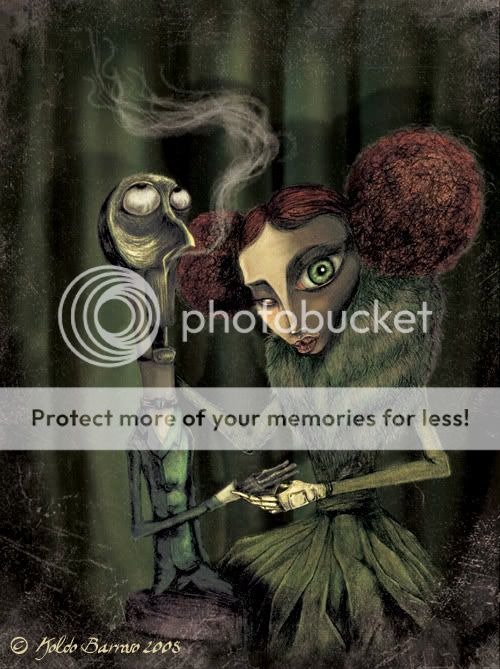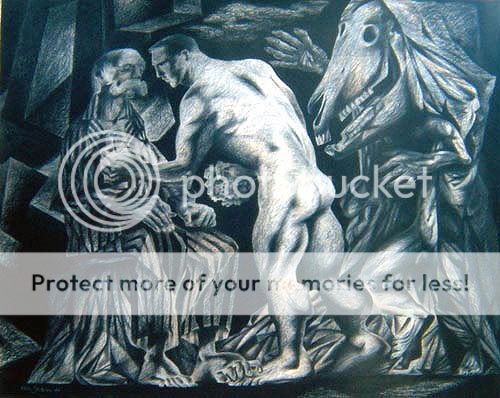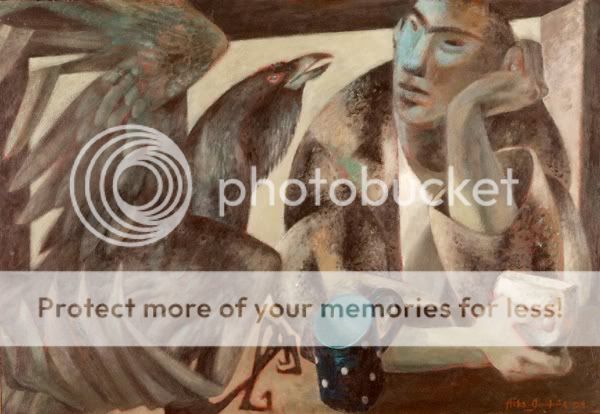of a good universe next door;let’s go
—e.e.cummings
 |
| From codex seraphinianus |
"Discover for yourself, reader, such wonders as the purple-caged citrus, the spider-web flower, the parfait protea, and the ladder weed. This is a world inhabited by weird half-sentient flora such as the tadpole tree and the meteor-fruit, by the lacy flying-saucer fish, the wheeled caterpillar-rumped horse, and the metamorphic bicranial rhino. The planet’s sentient species are here as well—races like the Garbage-Dwellers, the Road-Traffic and the Yarn People, and the exotic Rodent-Skin Wearers… Nor can we forget to mention the Homo-Saurians, whose unusual sexual life-cycle is graphically described." (From the inside jacket of the Codex Seraphinianus)
In 1940, Jorge Luis Borges wrote Tlon, Uqbar, Orbis Tertius, a fascinating account of the accidental discovery of an irregular addition to volume XLVI of a set of encyclopedias. The addition described the language, arts, geography, and history of an otherwise seemingly non-existent country, Uqbar, and its discovery left its two readers completely flummoxed. After a passage of time, the narrator happens upon another odd text, this time an entire volume which seems to have no twin in the world, and this time the entire book is devoted to the description of a planet, Tlön. He tells us:
(translations to English from http://www.coldbacon.com/writing/borges-tlon.html)
"Two years before I had discovered, in a volume of a certain pirated encyclopedia, a superficial description of a nonexistent country; now chance afforded me something more precious and arduous. Now I held in my hands a vast methodical fragment of an unknown planet's entire history, with its architecture and its playing cards, with the dread of its mythologies and the murmur of its languages, with its emperors and its seas, with its minerals and its birds and its fish, with its algebra and its fire, with its theological and metaphysical controversy. And all of it articulated, coherent, with no visible doctrinal intent or tone of parody."
 |
| From codex seraphinianus |
He goes on to describe some of the characteristics of this planet, for example the languages of the northern hemisphere, which are based almost entirely on the "monosyllabic adjective. The noun is formed by an accumulation of adjectives. They do not say "moon," but rather "round airy-light on dark" or "pale-orange-of-the-sky" or any other such combination. In the example selected the mass of adjectives refers to a real object, but this is purely fortuitous. The literature of this hemisphere (like Meinong's subsistent world) abounds in ideal objects, which are convoked and dissolved in a moment, according to poetic needs. At times they are determined by mere simultaneity. There are objects composed of two terms, one of visual and another of auditory character: the color of the rising sun and the faraway cry of a bird. There are objects of many terms: the sun and the water on a swimmer's chest, the vague tremulous rose color we see with our eyes closed, the sensation of being carried along by a river and also by sleep. These second-degree objects can be combined with others; through the use of certain abbreviations, the process is practically infinite. There are famous poems made up of one enormous word. This word forms a poetic object created by the author."
 |
| From codex seraphinianus |
In a postscript to the story, the narrator explains that new information has come to light, clarifying some of the mysteries surrounding the planet Tlön. A written confession has been discovered, detailing the existence of a secret society through several generations which sought to prove to a, in their eyes, "nonexistent God that mortal man was capable of conceiving a world." In a creepy turn of events, objects begin to appear which corroborate the actual existence of the planet, the first such object a compass with Tlön script on its metal case. Such intrusions of fantasy into the real world escalate until finally, the history of Tlön is being taught in the schools, Earth's science and archeology--its memories-- are being pushed aside for their Tlön counterparts, and the children are being taught to speak the language of Tlön. The story becomes a completely peaceful takeover of the planet Earth by a non-existent alien race.
 |
| From codex seraphinianus |
 |
| From codex seraphinianus |
 |
| From codex seraphinianus |
In 1976, Italian artist Luigi Serafini began work on just such a project--though I make no claims as to his hopes for a takeover of the planet. It is a masterfully illustrated encyclopedia of an unknown planet, with each illustration described, detailed, and explained in an unrecognizable alphabet. The alphabet has defied the attempts, so far, of linguists to break its code, even though a Rosetta Stone is given in the book--to another unknown language. According to Wikipedia, "Serafini has stated that the script of the Codex is asemic, and that his experience in writing it was closely similar to automatic writing." Though the writing has yet to be deciphered, many studies of it have been made. There is, for example, a brief analysis on the page (http://www.math.bas.bg/~iad/serafin.html):
"Which brings us back to the writing system. (I'm only discussing words written in majuscules here -- titles of chapters, sections, subsections and paragraphs, for the most part.) Several dozen different characters appear in them, far too many for the writing system to be an alphabet, and there are too many long words for it to be a syllabary. Some characters occur very many times, others only once or twice.
What is even more striking, however, is the tendency of the characters, even the less frequent ones, to reoccur within the same word or group of words (e.g., within the titles of the various subsections and paragraphs in a section). If a character occurs in a word at all, there's a good chance that it occurs there at least twice -- perhaps thrice in a row (which is next to unseen in any sort of phonetic writing system), up to six times altogether. It is as if the headers of most pages in an English book were such words as bookkeeper, googol, grammar, Ouagadougou and Wassamassaw. "
The numbering system has been deciphered. Meaning, it is an actual working system, though completely foreign to us. It is explained fully on the same webpage, with a few added notes:
"Telefol counting starts with the fingers of the left hand (1 being the pinky), progresses from the thumb (5) to the wrist, lower arm, elbow, upper arm and shoulder (6--10), the side of the neck, ear and eye (11--13) and thence through the nose (14) and right eye (15) to the right pinky finger (27). The Telefol idea of a very large number is kakkat=14*27=378. "
The book is filled with fantastic images.
The structure of the book is as follows:
"The Codex is divided into eleven chapters, partitioned into two sections. The first section appears to describe the natural world, dealing with flora, fauna, and physics. The second deals with the humanities, the various aspects of human life: clothing, history, cuisine, architecture and so on. Each chapter seems to treat a general encyclopedic topic. The topics of each separate chapter are as follows:
* The first chapter describes many alien types of flora: strange flowers, trees that uproot themselves and migrate, etc.
 |
| From codex seraphinianus |
* The second chapter is devoted to the fauna of this alien world, depicting many animals that are surreal variations of the horse, hippopotamus, rhinoceros, birds, etc.
 |
| From codex seraphinianus |
 |
| From codex seraphinianus |
* The third chapter deals with what seems to be a separate kingdom of odd bipedal creatures, apparently engineered for various purposes.
* The fourth chapter deals with something that seems to be physics and chemistry, and is by far the most abstract and enigmatic.
* The fifth chapter deals with bizarre machines and vehicles.
 |
| From codex seraphinianus |
 |
| From codex seraphinianus |
* The sixth chapter explores the general humanities: biology, sexuality, various aboriginal peoples, and even shows examples of plant life and tools (such as pens and wrenches) grafted directly into the human body.
* The seventh chapter is historical. It shows many people (some only vaguely human) of unknown significance, giving their times of birth and death. It also depicts many scenes of historical (and possibly religious) significance. Also included are examples of burial and funereal customs.
* The eighth chapter depicts the history of the Codex's alien writing system.
 |
| From codex seraphinianus |
* The ninth chapter deals with food, dining practices, and clothing.
* The tenth chapter describes bizarre games (including playing cards and board games) and athletic sports.
 |
| From codex seraphinianus |
* The eleventh chapter is devoted entirely to architecture."
(FROM WIKIPEDIA, with images inserted from various sites.)
On the page http://www.believermag.com/issues/200705/?read=article_taylor, Justin Taylor claims:
"As a book-object...the Codex’s only real precursor [!] is The Voynich Manuscript. Discovered by the Polish book collector Wilfrid M. Voynich in a wooden chest at an Italian Jesuit college in 1912, the heavily illustrated manuscript was worked on by top code-crackers during World War II. They failed. It’s never been deciphered. Theories on its origin and significance abound, including the theory that the manuscript is a fraud perpetrated by Voynich himself, but the most popular and conclusive theory attributes the work to Roger Bacon, the medieval Franciscan friar who, in his Letter Concerning the Marvelous Power of Art and Nature and the Nullity of Magic, noted that 'certain persons have achieved concealment by means of letters not then used by their own race or others but arbitrarily invented by themselves.'”
One thing should be pointed out here: the author of this codex is still very much alive. Meaning, we could have a full translation and explanation any day now. But I don't think we will.
 |
| From codex seraphinianus |
According to Shelley Jackson, author of Patchwork Girl,
"It’s important that it bothers you with the feeling that there is some content that you ought to be able to extract from it in a normal discursive kind of way. It’s meant to appeal to the rational or exegetical urge. It wants to be interpreted but it won’t let you, and it’s very interesting the way it teasingly asks to be read and then refuses. You could see this as a really really elaborate inkblot. It’s never going to completely yield to you in the sense of giving you insight into the artist’s intentions, so it kind of reverts you back on yourself and makes you notice what you’re noticing and notice the associations that you make. It’s a kind of springboard for your own creative musings.”
And I think that's key: your own creative musings. Keep that in mind for a minute.
Several years ago, there was an experiment run by a psychologist named Daniel Simmons. He showed the test subjects a video of groups of guys in black shirts and white shirts, tossing basketballs back and forth to each other on a court. He told the subjects to count the number of times a basketball got passed between the guys in white shirts. Halfway through the video, a gorilla-suited woman walked across the basketball court, and hardly anyone noticed. Why? Because they'd already been told what the important information was. How do you miss a gorilla? By working from a framework that causes your subconscious to discard the presence of the gorilla as unimportant information, before its presence even registers in your subconscious. And this experiment has been repeated many times, in various places, with the same results.
So I'm going to end here by pointing you back to the Foucault quote in my sidebar, where he refers to an excerpt of another Borges work, these quotes together reminding me of the importance of exposing yourself to as many outlandish and impossible modes of thinking as possible, and as often as possible, in order to erase more and more of the boundaries and limitations on your own system of thought, and thus your own ability to see all the gorillas that might be passing in front of you.
The Codex Seraphinianus is today's offering.
Note: YouTube user shivabel has uploaded this lovely, generous video of a large excerpt from the Codex Seraphinianus, showing you many, many more of the fantastic illustrations. The video is set to music by Penguin Cafe Orchestra:


























































